Commercial Cookery Project 1 - BSBCMM401 Make a Presentation Project
VerifiedAdded on 2022/12/27
|14
|3258
|52
Homework Assignment
AI Summary
This document is a comprehensive project solution for a Commercial Cookery assignment, specifically addressing the BSBCMM401 unit on making a presentation. The solution includes detailed answers to a series of questions covering various aspects of effective presentations. It starts by outlining the main purposes of presentations, followed by an analysis of audience characteristics and demographics. The document then delves into the crucial elements of presentation preparation, including regulatory and organizational requirements, and the principles of effective communication. It further explores the use of various aids and materials to support presentations, as well as techniques to enhance audience engagement. The project also includes researching persuasive communication techniques and outlining roles and responsibilities within a presentation. Additionally, the document discusses non-verbal communication, audience engagement, and methods for reviewing a presentation. The assignment provides a well-structured and insightful approach to the art of making a presentation, suitable for students studying commercial cookery.
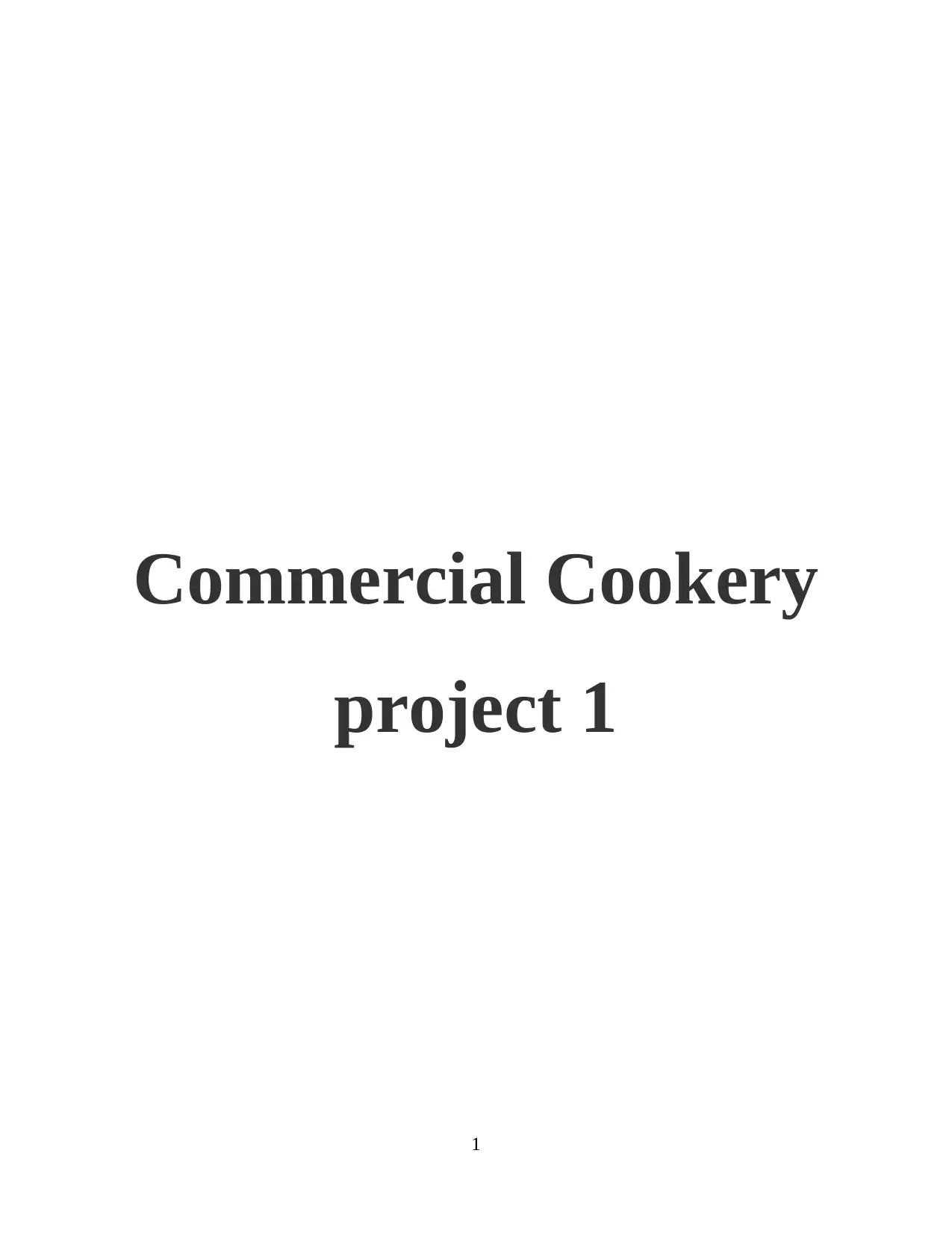
Commercial Cookery
project 1
1
project 1
1
Paraphrase This Document
Need a fresh take? Get an instant paraphrase of this document with our AI Paraphraser
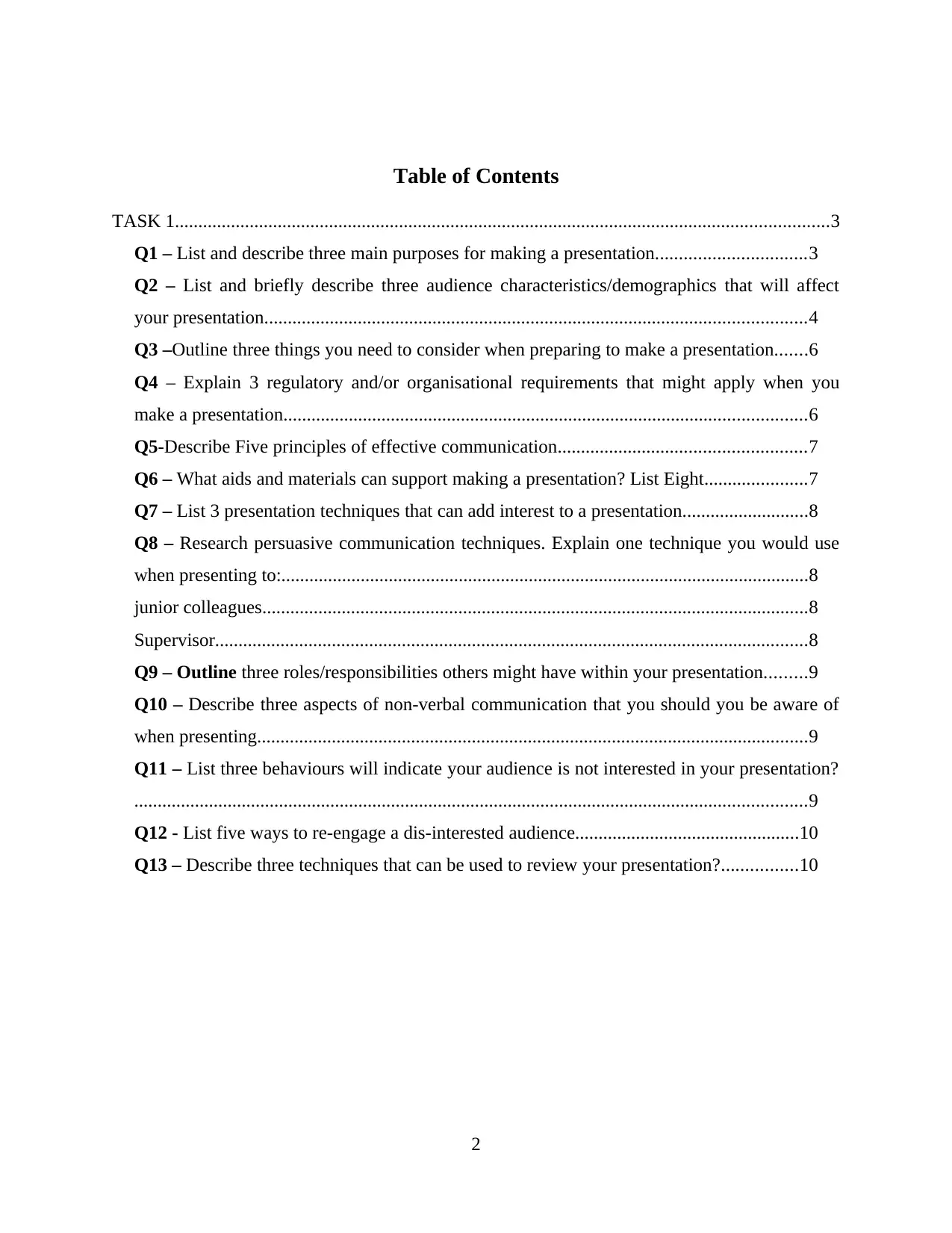
Table of Contents
TASK 1............................................................................................................................................3
Q1 – List and describe three main purposes for making a presentation................................3
Q2 – List and briefly describe three audience characteristics/demographics that will affect
your presentation....................................................................................................................4
Q3 –Outline three things you need to consider when preparing to make a presentation.......6
Q4 – Explain 3 regulatory and/or organisational requirements that might apply when you
make a presentation................................................................................................................6
Q5-Describe Five principles of effective communication.....................................................7
Q6 – What aids and materials can support making a presentation? List Eight......................7
Q7 – List 3 presentation techniques that can add interest to a presentation...........................8
Q8 – Research persuasive communication techniques. Explain one technique you would use
when presenting to:.................................................................................................................8
junior colleagues.....................................................................................................................8
Supervisor...............................................................................................................................8
Q9 – Outline three roles/responsibilities others might have within your presentation.........9
Q10 – Describe three aspects of non-verbal communication that you should you be aware of
when presenting......................................................................................................................9
Q11 – List three behaviours will indicate your audience is not interested in your presentation?
................................................................................................................................................9
Q12 - List five ways to re-engage a dis-interested audience................................................10
Q13 – Describe three techniques that can be used to review your presentation?................10
2
TASK 1............................................................................................................................................3
Q1 – List and describe three main purposes for making a presentation................................3
Q2 – List and briefly describe three audience characteristics/demographics that will affect
your presentation....................................................................................................................4
Q3 –Outline three things you need to consider when preparing to make a presentation.......6
Q4 – Explain 3 regulatory and/or organisational requirements that might apply when you
make a presentation................................................................................................................6
Q5-Describe Five principles of effective communication.....................................................7
Q6 – What aids and materials can support making a presentation? List Eight......................7
Q7 – List 3 presentation techniques that can add interest to a presentation...........................8
Q8 – Research persuasive communication techniques. Explain one technique you would use
when presenting to:.................................................................................................................8
junior colleagues.....................................................................................................................8
Supervisor...............................................................................................................................8
Q9 – Outline three roles/responsibilities others might have within your presentation.........9
Q10 – Describe three aspects of non-verbal communication that you should you be aware of
when presenting......................................................................................................................9
Q11 – List three behaviours will indicate your audience is not interested in your presentation?
................................................................................................................................................9
Q12 - List five ways to re-engage a dis-interested audience................................................10
Q13 – Describe three techniques that can be used to review your presentation?................10
2
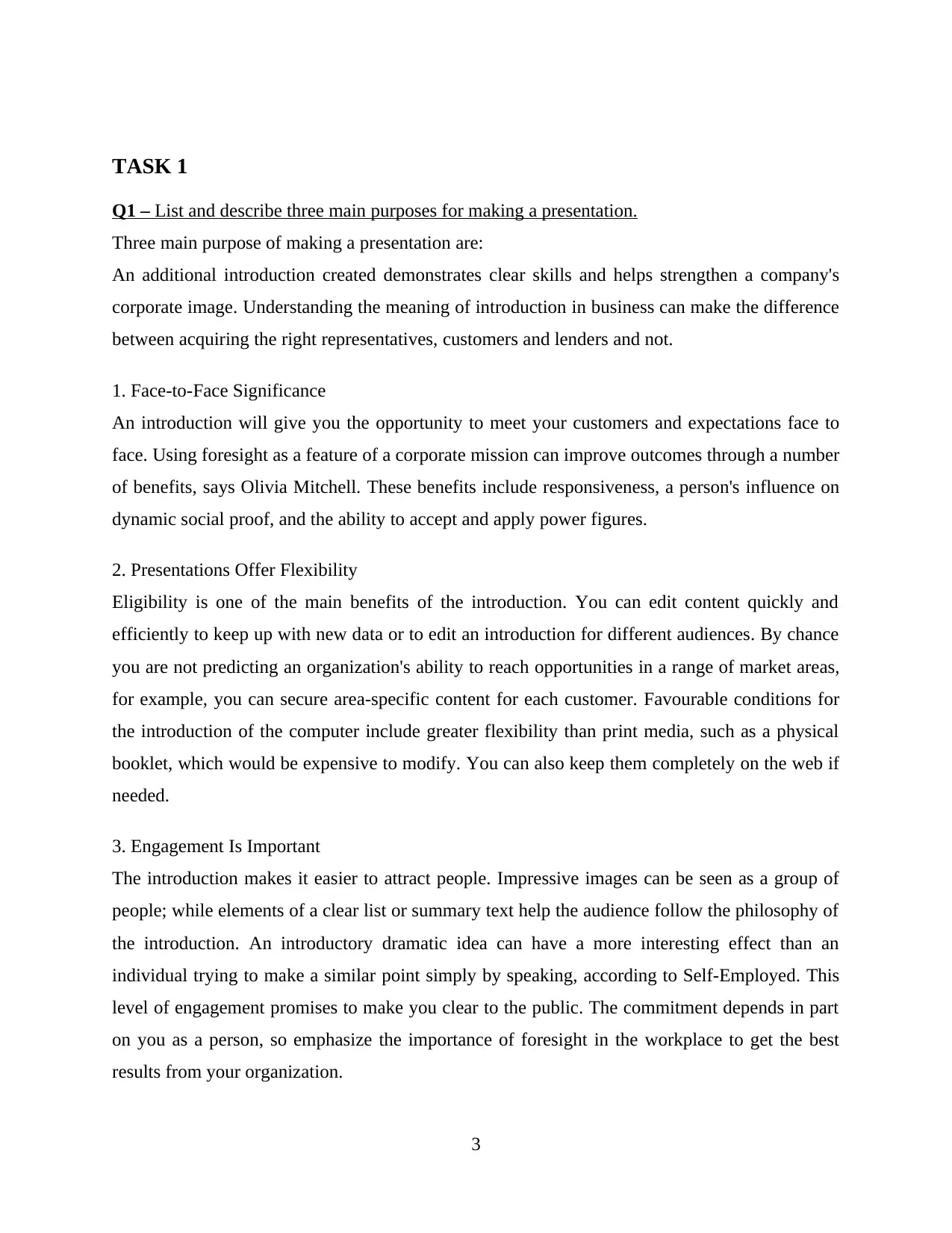
TASK 1
Q1 – List and describe three main purposes for making a presentation.
Three main purpose of making a presentation are:
An additional introduction created demonstrates clear skills and helps strengthen a company's
corporate image. Understanding the meaning of introduction in business can make the difference
between acquiring the right representatives, customers and lenders and not.
1. Face-to-Face Significance
An introduction will give you the opportunity to meet your customers and expectations face to
face. Using foresight as a feature of a corporate mission can improve outcomes through a number
of benefits, says Olivia Mitchell. These benefits include responsiveness, a person's influence on
dynamic social proof, and the ability to accept and apply power figures.
2. Presentations Offer Flexibility
Eligibility is one of the main benefits of the introduction. You can edit content quickly and
efficiently to keep up with new data or to edit an introduction for different audiences. By chance
you are not predicting an organization's ability to reach opportunities in a range of market areas,
for example, you can secure area-specific content for each customer. Favourable conditions for
the introduction of the computer include greater flexibility than print media, such as a physical
booklet, which would be expensive to modify. You can also keep them completely on the web if
needed.
3. Engagement Is Important
The introduction makes it easier to attract people. Impressive images can be seen as a group of
people; while elements of a clear list or summary text help the audience follow the philosophy of
the introduction. An introductory dramatic idea can have a more interesting effect than an
individual trying to make a similar point simply by speaking, according to Self-Employed. This
level of engagement promises to make you clear to the public. The commitment depends in part
on you as a person, so emphasize the importance of foresight in the workplace to get the best
results from your organization.
3
Q1 – List and describe three main purposes for making a presentation.
Three main purpose of making a presentation are:
An additional introduction created demonstrates clear skills and helps strengthen a company's
corporate image. Understanding the meaning of introduction in business can make the difference
between acquiring the right representatives, customers and lenders and not.
1. Face-to-Face Significance
An introduction will give you the opportunity to meet your customers and expectations face to
face. Using foresight as a feature of a corporate mission can improve outcomes through a number
of benefits, says Olivia Mitchell. These benefits include responsiveness, a person's influence on
dynamic social proof, and the ability to accept and apply power figures.
2. Presentations Offer Flexibility
Eligibility is one of the main benefits of the introduction. You can edit content quickly and
efficiently to keep up with new data or to edit an introduction for different audiences. By chance
you are not predicting an organization's ability to reach opportunities in a range of market areas,
for example, you can secure area-specific content for each customer. Favourable conditions for
the introduction of the computer include greater flexibility than print media, such as a physical
booklet, which would be expensive to modify. You can also keep them completely on the web if
needed.
3. Engagement Is Important
The introduction makes it easier to attract people. Impressive images can be seen as a group of
people; while elements of a clear list or summary text help the audience follow the philosophy of
the introduction. An introductory dramatic idea can have a more interesting effect than an
individual trying to make a similar point simply by speaking, according to Self-Employed. This
level of engagement promises to make you clear to the public. The commitment depends in part
on you as a person, so emphasize the importance of foresight in the workplace to get the best
results from your organization.
3
⊘ This is a preview!⊘
Do you want full access?
Subscribe today to unlock all pages.

Trusted by 1+ million students worldwide
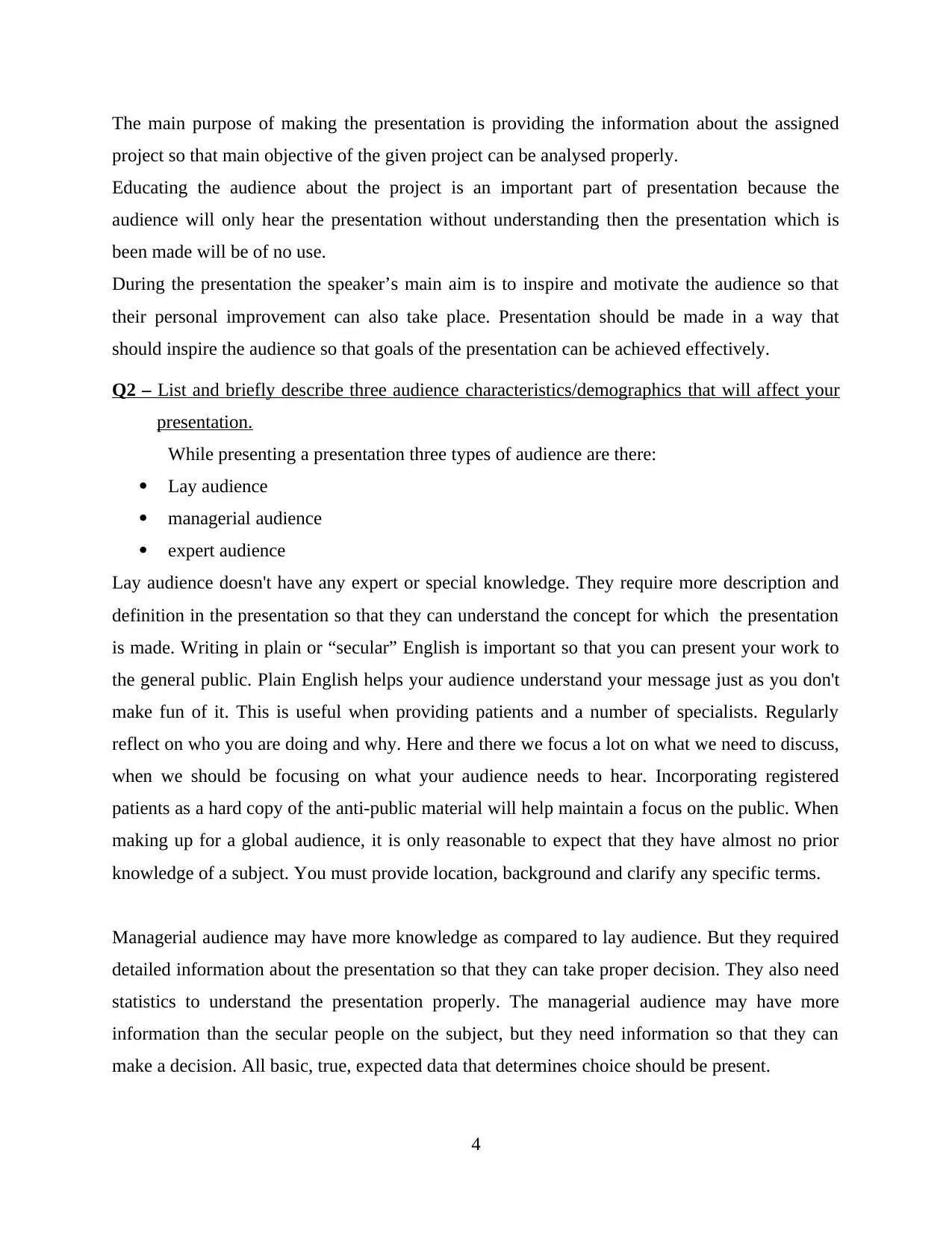
The main purpose of making the presentation is providing the information about the assigned
project so that main objective of the given project can be analysed properly.
Educating the audience about the project is an important part of presentation because the
audience will only hear the presentation without understanding then the presentation which is
been made will be of no use.
During the presentation the speaker’s main aim is to inspire and motivate the audience so that
their personal improvement can also take place. Presentation should be made in a way that
should inspire the audience so that goals of the presentation can be achieved effectively.
Q2 – List and briefly describe three audience characteristics/demographics that will affect your
presentation.
While presenting a presentation three types of audience are there:
Lay audience
managerial audience
expert audience
Lay audience doesn't have any expert or special knowledge. They require more description and
definition in the presentation so that they can understand the concept for which the presentation
is made. Writing in plain or “secular” English is important so that you can present your work to
the general public. Plain English helps your audience understand your message just as you don't
make fun of it. This is useful when providing patients and a number of specialists. Regularly
reflect on who you are doing and why. Here and there we focus a lot on what we need to discuss,
when we should be focusing on what your audience needs to hear. Incorporating registered
patients as a hard copy of the anti-public material will help maintain a focus on the public. When
making up for a global audience, it is only reasonable to expect that they have almost no prior
knowledge of a subject. You must provide location, background and clarify any specific terms.
Managerial audience may have more knowledge as compared to lay audience. But they required
detailed information about the presentation so that they can take proper decision. They also need
statistics to understand the presentation properly. The managerial audience may have more
information than the secular people on the subject, but they need information so that they can
make a decision. All basic, true, expected data that determines choice should be present.
4
project so that main objective of the given project can be analysed properly.
Educating the audience about the project is an important part of presentation because the
audience will only hear the presentation without understanding then the presentation which is
been made will be of no use.
During the presentation the speaker’s main aim is to inspire and motivate the audience so that
their personal improvement can also take place. Presentation should be made in a way that
should inspire the audience so that goals of the presentation can be achieved effectively.
Q2 – List and briefly describe three audience characteristics/demographics that will affect your
presentation.
While presenting a presentation three types of audience are there:
Lay audience
managerial audience
expert audience
Lay audience doesn't have any expert or special knowledge. They require more description and
definition in the presentation so that they can understand the concept for which the presentation
is made. Writing in plain or “secular” English is important so that you can present your work to
the general public. Plain English helps your audience understand your message just as you don't
make fun of it. This is useful when providing patients and a number of specialists. Regularly
reflect on who you are doing and why. Here and there we focus a lot on what we need to discuss,
when we should be focusing on what your audience needs to hear. Incorporating registered
patients as a hard copy of the anti-public material will help maintain a focus on the public. When
making up for a global audience, it is only reasonable to expect that they have almost no prior
knowledge of a subject. You must provide location, background and clarify any specific terms.
Managerial audience may have more knowledge as compared to lay audience. But they required
detailed information about the presentation so that they can take proper decision. They also need
statistics to understand the presentation properly. The managerial audience may have more
information than the secular people on the subject, but they need information so that they can
make a decision. All basic, true, expected data that determines choice should be present.
4
Paraphrase This Document
Need a fresh take? Get an instant paraphrase of this document with our AI Paraphraser
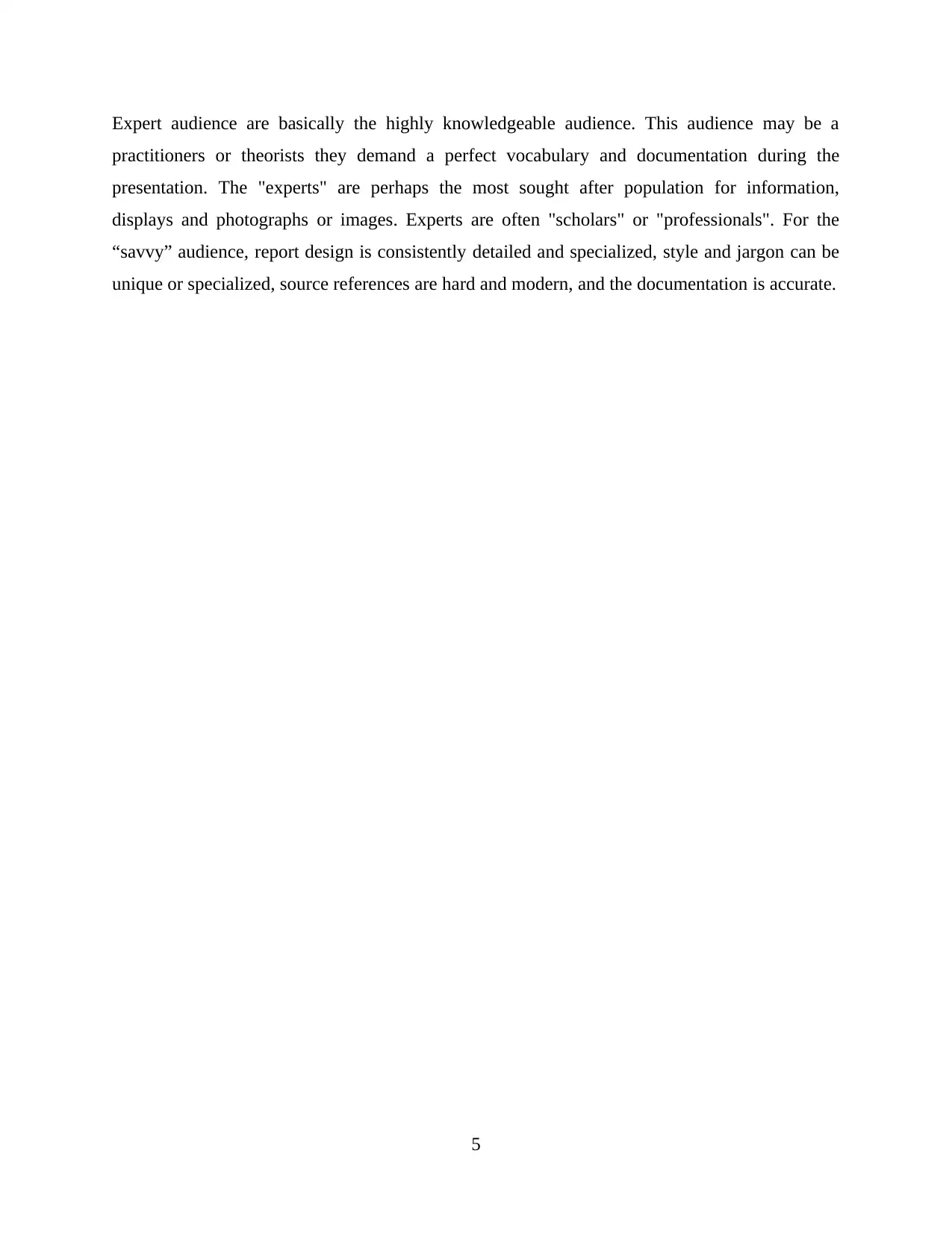
Expert audience are basically the highly knowledgeable audience. This audience may be a
practitioners or theorists they demand a perfect vocabulary and documentation during the
presentation. The "experts" are perhaps the most sought after population for information,
displays and photographs or images. Experts are often "scholars" or "professionals". For the
“savvy” audience, report design is consistently detailed and specialized, style and jargon can be
unique or specialized, source references are hard and modern, and the documentation is accurate.
5
practitioners or theorists they demand a perfect vocabulary and documentation during the
presentation. The "experts" are perhaps the most sought after population for information,
displays and photographs or images. Experts are often "scholars" or "professionals". For the
“savvy” audience, report design is consistently detailed and specialized, style and jargon can be
unique or specialized, source references are hard and modern, and the documentation is accurate.
5
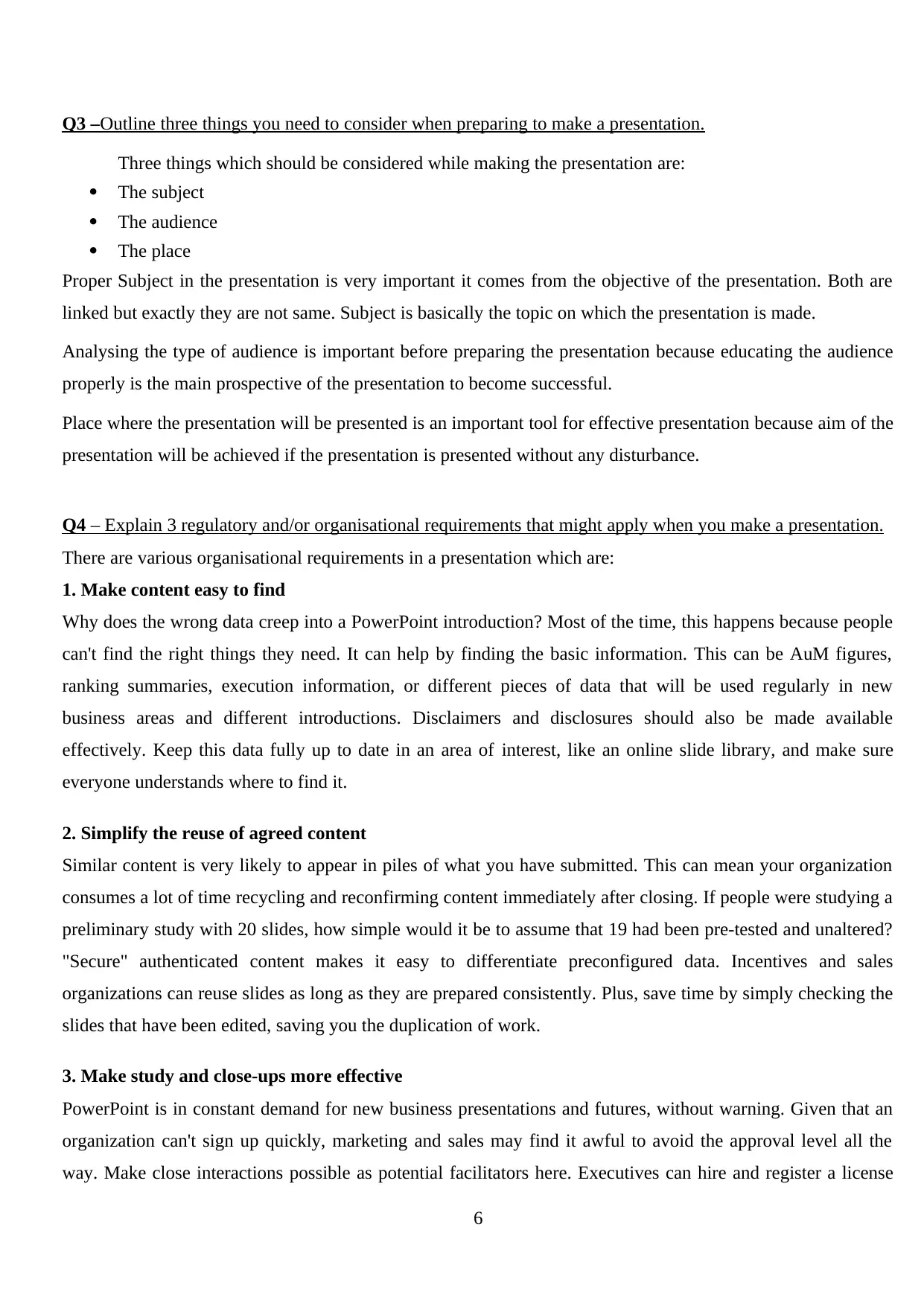
Q3 –Outline three things you need to consider when preparing to make a presentation.
Three things which should be considered while making the presentation are:
The subject
The audience
The place
Proper Subject in the presentation is very important it comes from the objective of the presentation. Both are
linked but exactly they are not same. Subject is basically the topic on which the presentation is made.
Analysing the type of audience is important before preparing the presentation because educating the audience
properly is the main prospective of the presentation to become successful.
Place where the presentation will be presented is an important tool for effective presentation because aim of the
presentation will be achieved if the presentation is presented without any disturbance.
Q4 – Explain 3 regulatory and/or organisational requirements that might apply when you make a presentation.
There are various organisational requirements in a presentation which are:
1. Make content easy to find
Why does the wrong data creep into a PowerPoint introduction? Most of the time, this happens because people
can't find the right things they need. It can help by finding the basic information. This can be AuM figures,
ranking summaries, execution information, or different pieces of data that will be used regularly in new
business areas and different introductions. Disclaimers and disclosures should also be made available
effectively. Keep this data fully up to date in an area of interest, like an online slide library, and make sure
everyone understands where to find it.
2. Simplify the reuse of agreed content
Similar content is very likely to appear in piles of what you have submitted. This can mean your organization
consumes a lot of time recycling and reconfirming content immediately after closing. If people were studying a
preliminary study with 20 slides, how simple would it be to assume that 19 had been pre-tested and unaltered?
"Secure" authenticated content makes it easy to differentiate preconfigured data. Incentives and sales
organizations can reuse slides as long as they are prepared consistently. Plus, save time by simply checking the
slides that have been edited, saving you the duplication of work.
3. Make study and close-ups more effective
PowerPoint is in constant demand for new business presentations and futures, without warning. Given that an
organization can't sign up quickly, marketing and sales may find it awful to avoid the approval level all the
way. Make close interactions possible as potential facilitators here. Executives can hire and register a license
6
Three things which should be considered while making the presentation are:
The subject
The audience
The place
Proper Subject in the presentation is very important it comes from the objective of the presentation. Both are
linked but exactly they are not same. Subject is basically the topic on which the presentation is made.
Analysing the type of audience is important before preparing the presentation because educating the audience
properly is the main prospective of the presentation to become successful.
Place where the presentation will be presented is an important tool for effective presentation because aim of the
presentation will be achieved if the presentation is presented without any disturbance.
Q4 – Explain 3 regulatory and/or organisational requirements that might apply when you make a presentation.
There are various organisational requirements in a presentation which are:
1. Make content easy to find
Why does the wrong data creep into a PowerPoint introduction? Most of the time, this happens because people
can't find the right things they need. It can help by finding the basic information. This can be AuM figures,
ranking summaries, execution information, or different pieces of data that will be used regularly in new
business areas and different introductions. Disclaimers and disclosures should also be made available
effectively. Keep this data fully up to date in an area of interest, like an online slide library, and make sure
everyone understands where to find it.
2. Simplify the reuse of agreed content
Similar content is very likely to appear in piles of what you have submitted. This can mean your organization
consumes a lot of time recycling and reconfirming content immediately after closing. If people were studying a
preliminary study with 20 slides, how simple would it be to assume that 19 had been pre-tested and unaltered?
"Secure" authenticated content makes it easy to differentiate preconfigured data. Incentives and sales
organizations can reuse slides as long as they are prepared consistently. Plus, save time by simply checking the
slides that have been edited, saving you the duplication of work.
3. Make study and close-ups more effective
PowerPoint is in constant demand for new business presentations and futures, without warning. Given that an
organization can't sign up quickly, marketing and sales may find it awful to avoid the approval level all the
way. Make close interactions possible as potential facilitators here. Executives can hire and register a license
6
⊘ This is a preview!⊘
Do you want full access?
Subscribe today to unlock all pages.

Trusted by 1+ million students worldwide
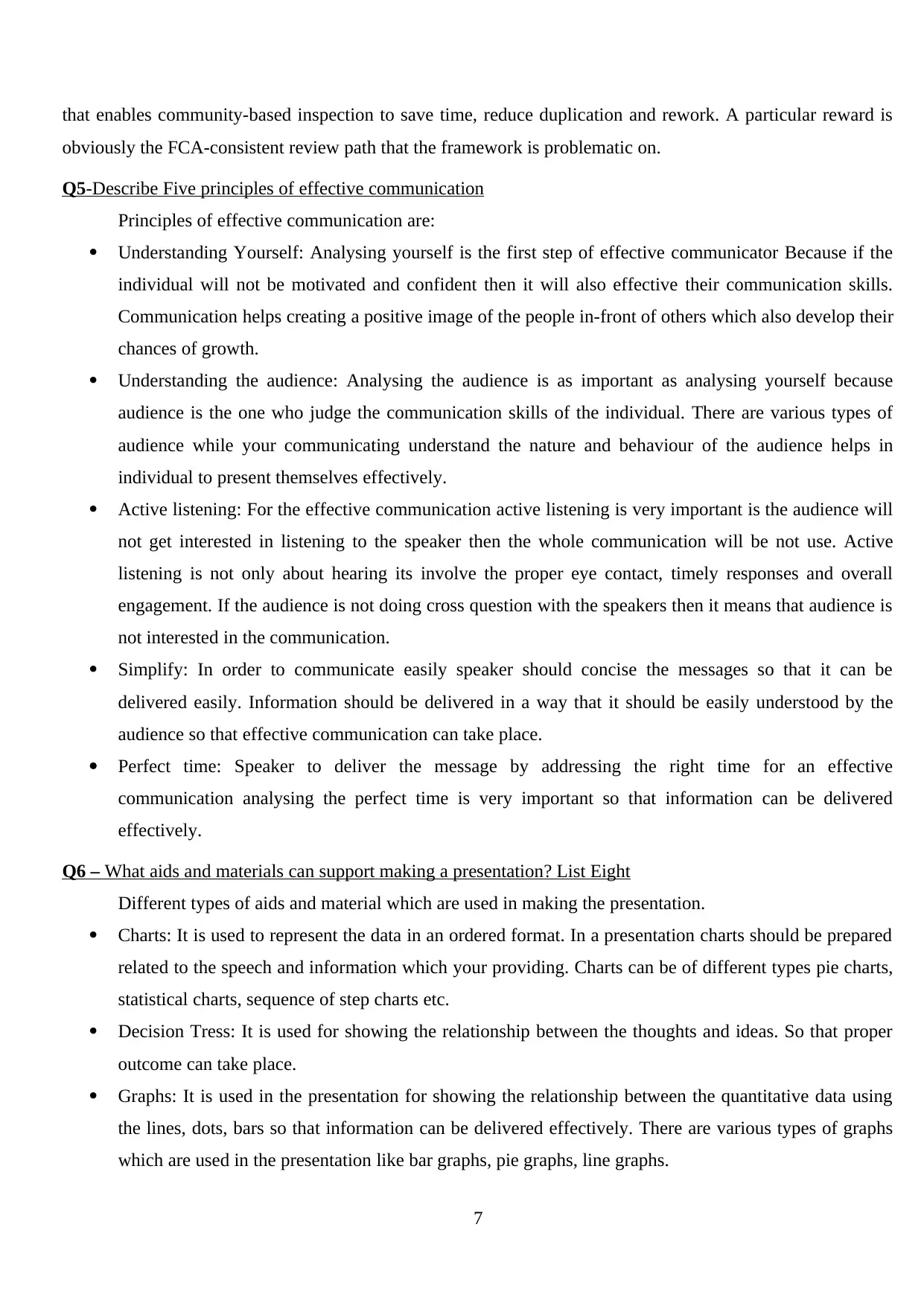
that enables community-based inspection to save time, reduce duplication and rework. A particular reward is
obviously the FCA-consistent review path that the framework is problematic on.
Q5-Describe Five principles of effective communication
Principles of effective communication are:
Understanding Yourself: Analysing yourself is the first step of effective communicator Because if the
individual will not be motivated and confident then it will also effective their communication skills.
Communication helps creating a positive image of the people in-front of others which also develop their
chances of growth.
Understanding the audience: Analysing the audience is as important as analysing yourself because
audience is the one who judge the communication skills of the individual. There are various types of
audience while your communicating understand the nature and behaviour of the audience helps in
individual to present themselves effectively.
Active listening: For the effective communication active listening is very important is the audience will
not get interested in listening to the speaker then the whole communication will be not use. Active
listening is not only about hearing its involve the proper eye contact, timely responses and overall
engagement. If the audience is not doing cross question with the speakers then it means that audience is
not interested in the communication.
Simplify: In order to communicate easily speaker should concise the messages so that it can be
delivered easily. Information should be delivered in a way that it should be easily understood by the
audience so that effective communication can take place.
Perfect time: Speaker to deliver the message by addressing the right time for an effective
communication analysing the perfect time is very important so that information can be delivered
effectively.
Q6 – What aids and materials can support making a presentation? List Eight
Different types of aids and material which are used in making the presentation.
Charts: It is used to represent the data in an ordered format. In a presentation charts should be prepared
related to the speech and information which your providing. Charts can be of different types pie charts,
statistical charts, sequence of step charts etc.
Decision Tress: It is used for showing the relationship between the thoughts and ideas. So that proper
outcome can take place.
Graphs: It is used in the presentation for showing the relationship between the quantitative data using
the lines, dots, bars so that information can be delivered effectively. There are various types of graphs
which are used in the presentation like bar graphs, pie graphs, line graphs.
7
obviously the FCA-consistent review path that the framework is problematic on.
Q5-Describe Five principles of effective communication
Principles of effective communication are:
Understanding Yourself: Analysing yourself is the first step of effective communicator Because if the
individual will not be motivated and confident then it will also effective their communication skills.
Communication helps creating a positive image of the people in-front of others which also develop their
chances of growth.
Understanding the audience: Analysing the audience is as important as analysing yourself because
audience is the one who judge the communication skills of the individual. There are various types of
audience while your communicating understand the nature and behaviour of the audience helps in
individual to present themselves effectively.
Active listening: For the effective communication active listening is very important is the audience will
not get interested in listening to the speaker then the whole communication will be not use. Active
listening is not only about hearing its involve the proper eye contact, timely responses and overall
engagement. If the audience is not doing cross question with the speakers then it means that audience is
not interested in the communication.
Simplify: In order to communicate easily speaker should concise the messages so that it can be
delivered easily. Information should be delivered in a way that it should be easily understood by the
audience so that effective communication can take place.
Perfect time: Speaker to deliver the message by addressing the right time for an effective
communication analysing the perfect time is very important so that information can be delivered
effectively.
Q6 – What aids and materials can support making a presentation? List Eight
Different types of aids and material which are used in making the presentation.
Charts: It is used to represent the data in an ordered format. In a presentation charts should be prepared
related to the speech and information which your providing. Charts can be of different types pie charts,
statistical charts, sequence of step charts etc.
Decision Tress: It is used for showing the relationship between the thoughts and ideas. So that proper
outcome can take place.
Graphs: It is used in the presentation for showing the relationship between the quantitative data using
the lines, dots, bars so that information can be delivered effectively. There are various types of graphs
which are used in the presentation like bar graphs, pie graphs, line graphs.
7
Paraphrase This Document
Need a fresh take? Get an instant paraphrase of this document with our AI Paraphraser
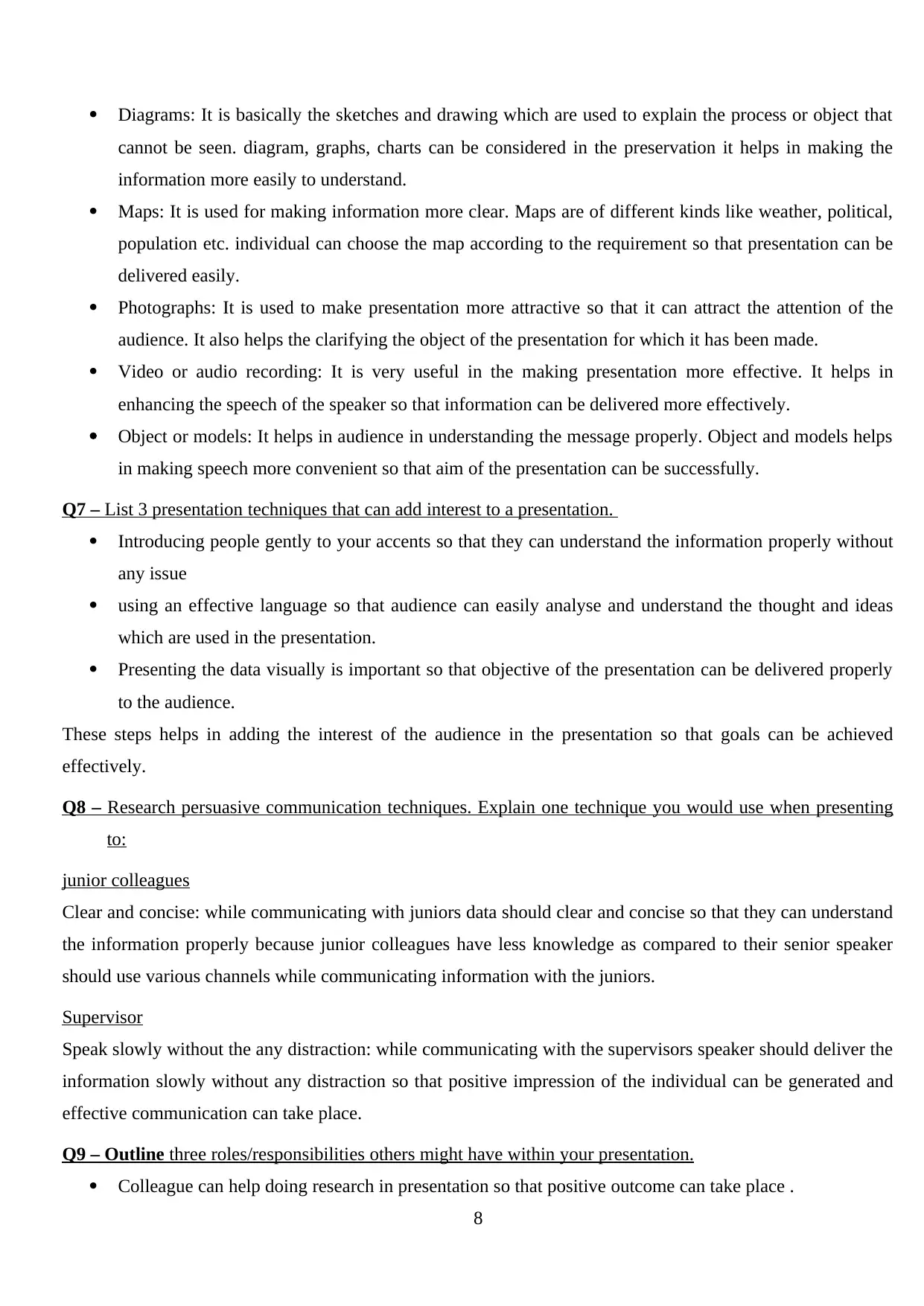
Diagrams: It is basically the sketches and drawing which are used to explain the process or object that
cannot be seen. diagram, graphs, charts can be considered in the preservation it helps in making the
information more easily to understand.
Maps: It is used for making information more clear. Maps are of different kinds like weather, political,
population etc. individual can choose the map according to the requirement so that presentation can be
delivered easily.
Photographs: It is used to make presentation more attractive so that it can attract the attention of the
audience. It also helps the clarifying the object of the presentation for which it has been made.
Video or audio recording: It is very useful in the making presentation more effective. It helps in
enhancing the speech of the speaker so that information can be delivered more effectively.
Object or models: It helps in audience in understanding the message properly. Object and models helps
in making speech more convenient so that aim of the presentation can be successfully.
Q7 – List 3 presentation techniques that can add interest to a presentation.
Introducing people gently to your accents so that they can understand the information properly without
any issue
using an effective language so that audience can easily analyse and understand the thought and ideas
which are used in the presentation.
Presenting the data visually is important so that objective of the presentation can be delivered properly
to the audience.
These steps helps in adding the interest of the audience in the presentation so that goals can be achieved
effectively.
Q8 – Research persuasive communication techniques. Explain one technique you would use when presenting
to:
junior colleagues
Clear and concise: while communicating with juniors data should clear and concise so that they can understand
the information properly because junior colleagues have less knowledge as compared to their senior speaker
should use various channels while communicating information with the juniors.
Supervisor
Speak slowly without the any distraction: while communicating with the supervisors speaker should deliver the
information slowly without any distraction so that positive impression of the individual can be generated and
effective communication can take place.
Q9 – Outline three roles/responsibilities others might have within your presentation.
Colleague can help doing research in presentation so that positive outcome can take place .
8
cannot be seen. diagram, graphs, charts can be considered in the preservation it helps in making the
information more easily to understand.
Maps: It is used for making information more clear. Maps are of different kinds like weather, political,
population etc. individual can choose the map according to the requirement so that presentation can be
delivered easily.
Photographs: It is used to make presentation more attractive so that it can attract the attention of the
audience. It also helps the clarifying the object of the presentation for which it has been made.
Video or audio recording: It is very useful in the making presentation more effective. It helps in
enhancing the speech of the speaker so that information can be delivered more effectively.
Object or models: It helps in audience in understanding the message properly. Object and models helps
in making speech more convenient so that aim of the presentation can be successfully.
Q7 – List 3 presentation techniques that can add interest to a presentation.
Introducing people gently to your accents so that they can understand the information properly without
any issue
using an effective language so that audience can easily analyse and understand the thought and ideas
which are used in the presentation.
Presenting the data visually is important so that objective of the presentation can be delivered properly
to the audience.
These steps helps in adding the interest of the audience in the presentation so that goals can be achieved
effectively.
Q8 – Research persuasive communication techniques. Explain one technique you would use when presenting
to:
junior colleagues
Clear and concise: while communicating with juniors data should clear and concise so that they can understand
the information properly because junior colleagues have less knowledge as compared to their senior speaker
should use various channels while communicating information with the juniors.
Supervisor
Speak slowly without the any distraction: while communicating with the supervisors speaker should deliver the
information slowly without any distraction so that positive impression of the individual can be generated and
effective communication can take place.
Q9 – Outline three roles/responsibilities others might have within your presentation.
Colleague can help doing research in presentation so that positive outcome can take place .
8
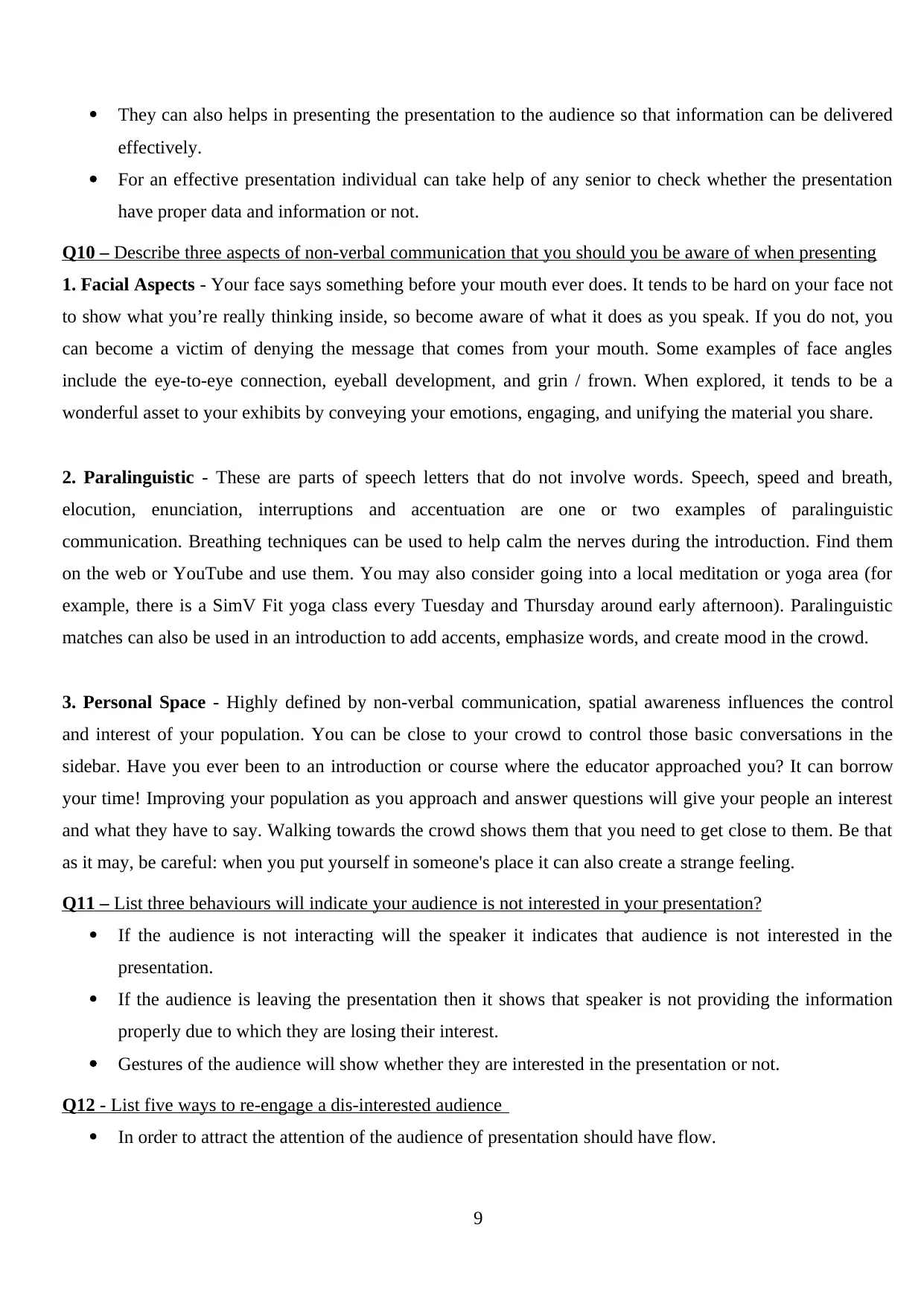
They can also helps in presenting the presentation to the audience so that information can be delivered
effectively.
For an effective presentation individual can take help of any senior to check whether the presentation
have proper data and information or not.
Q10 – Describe three aspects of non-verbal communication that you should you be aware of when presenting
1. Facial Aspects - Your face says something before your mouth ever does. It tends to be hard on your face not
to show what you’re really thinking inside, so become aware of what it does as you speak. If you do not, you
can become a victim of denying the message that comes from your mouth. Some examples of face angles
include the eye-to-eye connection, eyeball development, and grin / frown. When explored, it tends to be a
wonderful asset to your exhibits by conveying your emotions, engaging, and unifying the material you share.
2. Paralinguistic - These are parts of speech letters that do not involve words. Speech, speed and breath,
elocution, enunciation, interruptions and accentuation are one or two examples of paralinguistic
communication. Breathing techniques can be used to help calm the nerves during the introduction. Find them
on the web or YouTube and use them. You may also consider going into a local meditation or yoga area (for
example, there is a SimV Fit yoga class every Tuesday and Thursday around early afternoon). Paralinguistic
matches can also be used in an introduction to add accents, emphasize words, and create mood in the crowd.
3. Personal Space - Highly defined by non-verbal communication, spatial awareness influences the control
and interest of your population. You can be close to your crowd to control those basic conversations in the
sidebar. Have you ever been to an introduction or course where the educator approached you? It can borrow
your time! Improving your population as you approach and answer questions will give your people an interest
and what they have to say. Walking towards the crowd shows them that you need to get close to them. Be that
as it may, be careful: when you put yourself in someone's place it can also create a strange feeling.
Q11 – List three behaviours will indicate your audience is not interested in your presentation?
If the audience is not interacting will the speaker it indicates that audience is not interested in the
presentation.
If the audience is leaving the presentation then it shows that speaker is not providing the information
properly due to which they are losing their interest.
Gestures of the audience will show whether they are interested in the presentation or not.
Q12 - List five ways to re-engage a dis-interested audience
In order to attract the attention of the audience of presentation should have flow.
9
effectively.
For an effective presentation individual can take help of any senior to check whether the presentation
have proper data and information or not.
Q10 – Describe three aspects of non-verbal communication that you should you be aware of when presenting
1. Facial Aspects - Your face says something before your mouth ever does. It tends to be hard on your face not
to show what you’re really thinking inside, so become aware of what it does as you speak. If you do not, you
can become a victim of denying the message that comes from your mouth. Some examples of face angles
include the eye-to-eye connection, eyeball development, and grin / frown. When explored, it tends to be a
wonderful asset to your exhibits by conveying your emotions, engaging, and unifying the material you share.
2. Paralinguistic - These are parts of speech letters that do not involve words. Speech, speed and breath,
elocution, enunciation, interruptions and accentuation are one or two examples of paralinguistic
communication. Breathing techniques can be used to help calm the nerves during the introduction. Find them
on the web or YouTube and use them. You may also consider going into a local meditation or yoga area (for
example, there is a SimV Fit yoga class every Tuesday and Thursday around early afternoon). Paralinguistic
matches can also be used in an introduction to add accents, emphasize words, and create mood in the crowd.
3. Personal Space - Highly defined by non-verbal communication, spatial awareness influences the control
and interest of your population. You can be close to your crowd to control those basic conversations in the
sidebar. Have you ever been to an introduction or course where the educator approached you? It can borrow
your time! Improving your population as you approach and answer questions will give your people an interest
and what they have to say. Walking towards the crowd shows them that you need to get close to them. Be that
as it may, be careful: when you put yourself in someone's place it can also create a strange feeling.
Q11 – List three behaviours will indicate your audience is not interested in your presentation?
If the audience is not interacting will the speaker it indicates that audience is not interested in the
presentation.
If the audience is leaving the presentation then it shows that speaker is not providing the information
properly due to which they are losing their interest.
Gestures of the audience will show whether they are interested in the presentation or not.
Q12 - List five ways to re-engage a dis-interested audience
In order to attract the attention of the audience of presentation should have flow.
9
⊘ This is a preview!⊘
Do you want full access?
Subscribe today to unlock all pages.

Trusted by 1+ million students worldwide
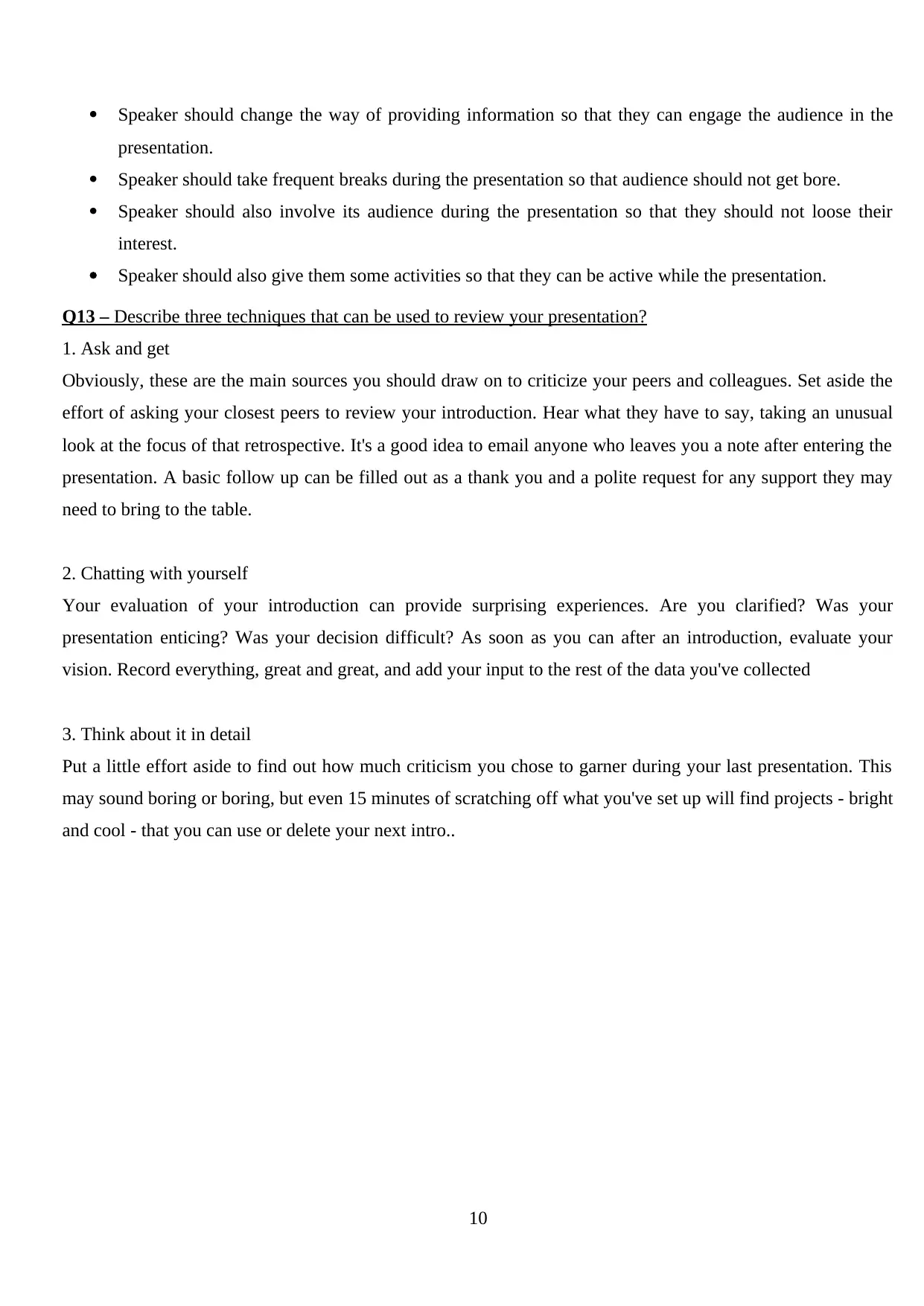
Speaker should change the way of providing information so that they can engage the audience in the
presentation.
Speaker should take frequent breaks during the presentation so that audience should not get bore.
Speaker should also involve its audience during the presentation so that they should not loose their
interest.
Speaker should also give them some activities so that they can be active while the presentation.
Q13 – Describe three techniques that can be used to review your presentation?
1. Ask and get
Obviously, these are the main sources you should draw on to criticize your peers and colleagues. Set aside the
effort of asking your closest peers to review your introduction. Hear what they have to say, taking an unusual
look at the focus of that retrospective. It's a good idea to email anyone who leaves you a note after entering the
presentation. A basic follow up can be filled out as a thank you and a polite request for any support they may
need to bring to the table.
2. Chatting with yourself
Your evaluation of your introduction can provide surprising experiences. Are you clarified? Was your
presentation enticing? Was your decision difficult? As soon as you can after an introduction, evaluate your
vision. Record everything, great and great, and add your input to the rest of the data you've collected
3. Think about it in detail
Put a little effort aside to find out how much criticism you chose to garner during your last presentation. This
may sound boring or boring, but even 15 minutes of scratching off what you've set up will find projects - bright
and cool - that you can use or delete your next intro..
10
presentation.
Speaker should take frequent breaks during the presentation so that audience should not get bore.
Speaker should also involve its audience during the presentation so that they should not loose their
interest.
Speaker should also give them some activities so that they can be active while the presentation.
Q13 – Describe three techniques that can be used to review your presentation?
1. Ask and get
Obviously, these are the main sources you should draw on to criticize your peers and colleagues. Set aside the
effort of asking your closest peers to review your introduction. Hear what they have to say, taking an unusual
look at the focus of that retrospective. It's a good idea to email anyone who leaves you a note after entering the
presentation. A basic follow up can be filled out as a thank you and a polite request for any support they may
need to bring to the table.
2. Chatting with yourself
Your evaluation of your introduction can provide surprising experiences. Are you clarified? Was your
presentation enticing? Was your decision difficult? As soon as you can after an introduction, evaluate your
vision. Record everything, great and great, and add your input to the rest of the data you've collected
3. Think about it in detail
Put a little effort aside to find out how much criticism you chose to garner during your last presentation. This
may sound boring or boring, but even 15 minutes of scratching off what you've set up will find projects - bright
and cool - that you can use or delete your next intro..
10
Paraphrase This Document
Need a fresh take? Get an instant paraphrase of this document with our AI Paraphraser

11

12
⊘ This is a preview!⊘
Do you want full access?
Subscribe today to unlock all pages.

Trusted by 1+ million students worldwide
1 out of 14
Related Documents
Your All-in-One AI-Powered Toolkit for Academic Success.
+13062052269
info@desklib.com
Available 24*7 on WhatsApp / Email
![[object Object]](/_next/static/media/star-bottom.7253800d.svg)
Unlock your academic potential
Copyright © 2020–2025 A2Z Services. All Rights Reserved. Developed and managed by ZUCOL.





